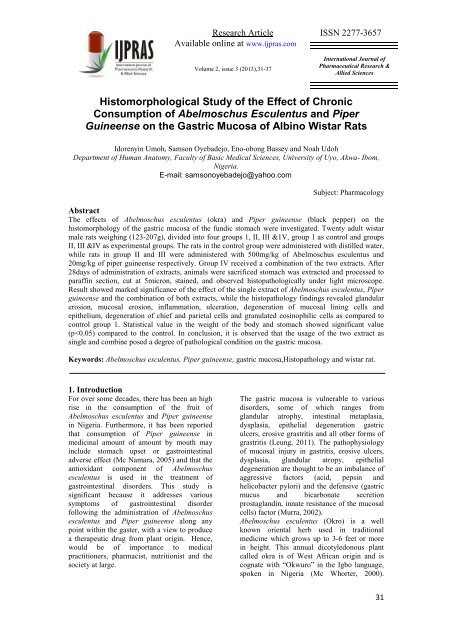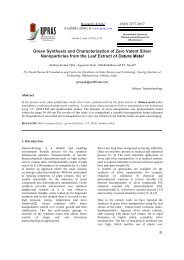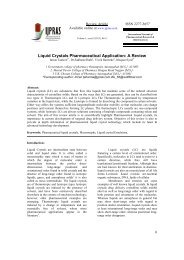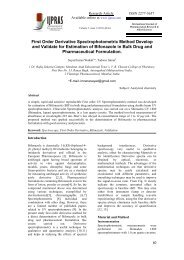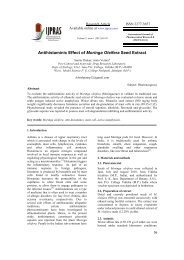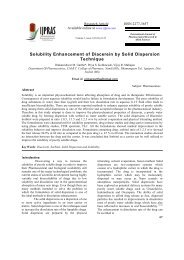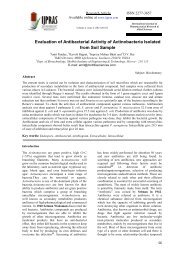Histomorphological study on gastric mucosa of albino wistar rats
Histomorphological study on gastric mucosa of albino wistar rats
Histomorphological study on gastric mucosa of albino wistar rats
- No tags were found...
Create successful ePaper yourself
Turn your PDF publications into a flip-book with our unique Google optimized e-Paper software.
Research Article ISSN 2277-3657Available <strong>on</strong>line at www.ijpras.comVolume 2, issue 3 (2013),31-37Internati<strong>on</strong>al Journal <strong>of</strong>Pharmaceutical Research &Allied Sciences<str<strong>on</strong>g>Histomorphological</str<strong>on</strong>g> Study <strong>of</strong> the Effect <strong>of</strong> Chr<strong>on</strong>icC<strong>on</strong>sumpti<strong>on</strong> <strong>of</strong> Abelmoschus Esculentus and PiperGuineense <strong>on</strong> the Gastric Mucosa <strong>of</strong> Albino Wistar RatsIdorenyin Umoh, Sams<strong>on</strong> Oyebadejo, Eno-ob<strong>on</strong>g Bassey and Noah UdohDepartment <strong>of</strong> Human Anatomy, Faculty <strong>of</strong> Basic Medical Sciences, University <strong>of</strong> Uyo, Akwa- Ibom,Nigeria.E-mail: sams<strong>on</strong>oyebadejo@yahoo.comSubject: PharmacologyAbstractThe effects <strong>of</strong> Abelmoschus esculentus (okra) and Piper guineense (black pepper) <strong>on</strong> thehistomorphology <strong>of</strong> the <strong>gastric</strong> <strong>mucosa</strong> <strong>of</strong> the fundic stomach were investigated. Twenty adult <strong>wistar</strong>male <strong>rats</strong> weighing (123-207g), divided into four groups 1, II, III &1V, group 1 as c<strong>on</strong>trol and groupsII, III &IV as experimental groups. The <strong>rats</strong> in the c<strong>on</strong>trol group were administered with distilled water,while <strong>rats</strong> in group II and III were administered with 500mg/kg <strong>of</strong> Abelmoschus esculentus and20mg/kg <strong>of</strong> piper guineense respectively. Group IV received a combinati<strong>on</strong> <strong>of</strong> the two extracts. After28days <strong>of</strong> administrati<strong>on</strong> <strong>of</strong> extracts, animals were sacrificed stomach was extracted and processed toparaffin secti<strong>on</strong>, cut at 5micr<strong>on</strong>, stained, and observed histopathologically under light microscope.Result showed marked significance <strong>of</strong> the effect <strong>of</strong> the single extract <strong>of</strong> Abelmoschus esculentus, Piperguineense and the combinati<strong>on</strong> <strong>of</strong> both extracts, while the histopathology findings revealed glandularerosi<strong>on</strong>, <strong>mucosa</strong>l erosi<strong>on</strong>, inflammati<strong>on</strong>, ulcerati<strong>on</strong>, degenerati<strong>on</strong> <strong>of</strong> <strong>mucosa</strong>l lining cells andepithelium, degenerati<strong>on</strong> <strong>of</strong> chief and parietal cells and granulated eosinophilic cells as compared toc<strong>on</strong>trol group 1. Statistical value in the weight <strong>of</strong> the body and stomach showed significant value(p
Available <strong>on</strong>line at www.ijpras.comAbelmoschus esculentus, popularly knownam<strong>on</strong>g the Ibibio people <strong>of</strong> South-SouthernNigeria as “Etighi”, is used for the treatment <strong>of</strong><strong>gastric</strong> problem <strong>on</strong> account <strong>of</strong> its mucilaginousc<strong>on</strong>tent. It has also been reported that the fruit<strong>of</strong> this medicinal plant is c<strong>on</strong>sidered anemollient, demulcent and diuretic withstimulant and vulnerary activities (James.1993). This l<strong>on</strong>g green pod vegetable with agreen fury outer skin, thin green flesh andsmall edible white seed is eaten in manydifferent ways like; stir fried, cooked in soup,prickled, cooked in meat stew, with soy sauce,with sugar, with rice, deep fried, and even withfresh salads. The seeds are useful in theproducti<strong>on</strong> <strong>of</strong> Okra oil (Mays, 2007).Piper guineense, also known as African blackpepper or hot leave is widely c<strong>on</strong>sumed insome part <strong>of</strong> West Africa especially Nigeriaand Ghana <strong>on</strong> account <strong>of</strong> its nutriti<strong>on</strong>al andMedicinal properties (Negbenebor, 1999).Piper guineense also known as Kale, Guineapepper, Sasema, leulaube, Sorowiso, Guineacubeb, Masoro, false cubeb pepper, Beninpeper. Like other members <strong>of</strong> the pepperfamily, Piper guineense is a climbing vine thatcan grow up to twenty meters in length, withglossy leaves which are about six inches l<strong>on</strong>g(Delziel, 1937). According to Irvine, they arenative to the tropical regi<strong>on</strong>s <strong>of</strong> central andWestern Africa and Semi-cultivated incountries such as Nigeria where the leavesknown as “etinkene, odusa am<strong>on</strong>g theEfik/Ibibo and “Uziza” am<strong>on</strong>g the Igbo areused as flavouring for stew.The medicinal value <strong>of</strong> this African speciesranges from the treatment <strong>of</strong> respiratorydiseases to correcti<strong>on</strong> <strong>of</strong> female infertilityproblems, c<strong>on</strong>trol <strong>of</strong> weight uterine c<strong>on</strong>tracti<strong>on</strong>for the expulsi<strong>on</strong> <strong>of</strong> placenta and other remainsfrom the womb (Udoh, 1999). Theantiparasitic, antimicrobial and antifungalactivities <strong>of</strong> the leaf and seeds <strong>of</strong> PiperGuineense have also been reported (Ekanemand Obiekezie, 2000; Ngane, 2003; Ekanem,2010).However, it has been reported that seed <strong>of</strong>Abelmoschus esculentus have antioxidanteffect (Ansari, 2009). Antioxidant potential <strong>of</strong>the seeds <strong>of</strong> Abelmoschus esculentus and thetraditi<strong>on</strong>al use <strong>of</strong> this plant in the treatment <strong>of</strong>gastrointestinal disorders has been the rati<strong>on</strong>alefor this <str<strong>on</strong>g>study</str<strong>on</strong>g>.On the other hand, studies have revealed thatpiperine, found in Piper guineense couldprevent gastrointestinal disorders developingfrom stress, hyperacidity and overgrowth <strong>of</strong>Helicobacter Pylori (Bai, 2000). However,possible side effects <strong>of</strong> taking Piper guineensein medicinal amount by mouth may includestomach upset or other gastrointestinal adverseeffects (Mc Namara, 2005),this signify thepurpose in which is why this <str<strong>on</strong>g>study</str<strong>on</strong>g> isundertaken to <str<strong>on</strong>g>study</str<strong>on</strong>g> the chr<strong>on</strong>ic c<strong>on</strong>sumpti<strong>on</strong><strong>of</strong> the plant when taking together to establishthe histopathological effect .2.0 Materials and Methods2.1 Drugs and ChemicalsSodium chloride, formaldehyde, sodiumtrioxocarb<strong>on</strong>ade V, sodium bicarbornate,xylene, 70% alcohol, 90% alcohol, absolutealcohol, haematoxylin, eosin, egg albumin,distilled water, paraffin wax were all procuredfrom BDH Chemicals, England. All otherchemicals were <strong>of</strong> analytical grade.2.2 Animals20 <strong>wistar</strong> <strong>rats</strong> (123-207g) were obtained fromthe University <strong>of</strong> Uyo animal house. Theywere maintained <strong>on</strong> standard pellets (guineafeed) and water ad libitum. Permissi<strong>on</strong> andapproval for animal studies were obtainedfrom the college <strong>of</strong> health sciences animalethnics committee, University <strong>of</strong> Uyo.2.3 Sourcing <strong>of</strong> Plant materialFreshly fruit <strong>of</strong> Abelmoschus esculentus andpiper guineense were obtained in July, 2012from Itam market, Uyo, Akwa Ibom State,Nigeria. The plant was identified andauthenticated by the Department <strong>of</strong> Botany,University <strong>of</strong> Uyo, Uyo, Nigeria.2.4 Preparati<strong>on</strong> <strong>of</strong> ExtractAbelmoschus esculentus was chopped and airdried. Piper guineese (seeds) was also air driedand after being dried they weighed 600g forAbelmoschus esculentus and 800g for Piperguineense. They were then macerated in 97%ethanol (SIGMA CO., UK) in a flat bottomflask and were kept for 72hrs at roomtemperature. At the end <strong>of</strong> 72hrs it wasfiltered. The filtrates were c<strong>on</strong>centrated inwater bath at 45 degree Celsius. Thec<strong>on</strong>centrated extract was preserved inrefrigerator till commencement <strong>of</strong> research.The weight <strong>of</strong> the extracts was 40.25g forAbelmoschus esculentus and 24g for Piperguineense.2.5 Acute Toxicity testing.The acute toxicity <strong>of</strong> Abelmoschus esculentusand Piper guineense <strong>on</strong> Wistar Albino <strong>rats</strong>were determined in two (2) stages for the twoextracts.For Abelmeschus esculentus, in stage <strong>on</strong>eanimals received 1000, 2000, 3000, 4000 and32
Available <strong>on</strong>line at www.ijpras.com5000mg/kg body weight while in stage two,animals received 2300, 2400, 2500, 2600,2700mg/kg body weight.In acute toxicity <strong>of</strong> Piper guineensethe same two stages was observed, in stage<strong>on</strong>e; animals received 10, 50, 100, 200, 300mg/kg body weight. Stage 2; received 85, 90,95, 100, 105 mg/kg body weight.All experimental animals were observed forphysical signs <strong>of</strong> toxicity such as writhing,gasping, palpitati<strong>on</strong>, decreased respiratory rate,body limb and death within 24hours. Theextract was administered intraperit<strong>on</strong>eally(i.p). The LD50 was found to be 2500mg/kgfor Albemoschus esculentus and 100mg/kg forPiper guineense .According to the modified lorke’smethod.500mg/kg and 20mg/kg per bodyweight were calculated respectively as middledoses for the Albemoschus esculentus andPiper guineense. Doses were c<strong>on</strong>sidered asstock soluti<strong>on</strong>, they were calculated furtherusing 20mls <strong>of</strong> distilled water for Albemoschusesculentus and 10 mls <strong>of</strong> distilled water forPiper guineense to obtain working soluti<strong>on</strong>.2.6 Experimental Design/Study designMatured 20 <strong>albino</strong> <strong>wistar</strong> male <strong>rats</strong> weighingbetween 123-207g were obtained from thefaculty <strong>of</strong> Basic Medical SciencesExperimental Research Animal House <strong>of</strong> theUniversity <strong>of</strong> Uyo, Uyo Nigeria. They werefed with standard laboratory diet and water adlibitum. Illuminati<strong>on</strong> was 12h light /dark cycleand room temperature was 25±2 o C. Theanimals were divided into four groups, <strong>on</strong>ec<strong>on</strong>trol (1) and three experimental groups (II,III and IV), which c<strong>on</strong>sisted <strong>of</strong> 5 normal abino<strong>wistar</strong> <strong>rats</strong> per group. The c<strong>on</strong>trol group wasgiven distilled water while the experimentalgroup II, III and IV were exposed daily to500mg/kg body weight <strong>of</strong> Abelmoschusesculentus al<strong>on</strong>e, 20 mg/kg <strong>of</strong> body weightpiper guinenese al<strong>on</strong>e and 500 mg/kg <strong>of</strong>Abelmoschus esculentus combined with 20mg/kg <strong>of</strong> piper gineense respectively by oraladministrati<strong>on</strong> for 28 days. In this <str<strong>on</strong>g>study</str<strong>on</strong>g>, all theanimals’ experimentati<strong>on</strong>s were carried outfollowing the guidelines for the care and use <strong>of</strong>laboratory animals obtained from theinstituti<strong>on</strong>al animal ethics committee.2.7 Sample collecti<strong>on</strong> and Histopathologicalanalysis.Twenty four hours after last exposure, theanimal were anesthetized with chlor<strong>of</strong>ormvapour and dissected. The harvested stomachwere carefully dissected out, trimmed <strong>of</strong> all fatand c<strong>on</strong>nective tissue blotted dry to removeany blood. The tissues were fixed in 10%formal saline, and then transferred to a gradedseries <strong>of</strong> ethanol. On day 1, they were placedin 70% alcohol for 7 hours, then transferred to90% alcohol and left in the latter overnight. Onday 2, the tissues were passed through threechanges <strong>of</strong> absolute alcohol for an hour eachthen cleared in xylene. Once cleared, thetissues were infiltrated in molten paraffin waxin the oven at 58°C. Three changes <strong>of</strong> moltenparaffin wax at <strong>on</strong>e-hour intervals were made,after which the tissues were embedded in waxand blocked out. Prior to embedding, it wasensured that the mounted secti<strong>on</strong>s to be cut bythe rotary microtome were orientatedperpendicularly to the l<strong>on</strong>g axis <strong>of</strong> the kidney,liver and pancreas. The secti<strong>on</strong>s weredesignated "vertical secti<strong>on</strong>s". Serial secti<strong>on</strong>s<strong>of</strong> 5 µm thick were obtained from a solid block<strong>of</strong> tissue, fixed <strong>on</strong> clean albuminized slides toprevent secti<strong>on</strong>s coming <strong>of</strong>f the slides and laterstained with Haematoxylin and Eosin stainingtechniques, after which they were passedthrough ascending grade <strong>of</strong> alcohol, cleared inxylene and mount in DPX mountant, allowedto dry at room temperature and observedHistopathologically under digital lightmicroscope.2.8 Gross morphometrical analysisThe initial and final weight <strong>of</strong> the <strong>rats</strong> and theweight <strong>of</strong> the kidney in each group were takenusing the weighing balance. The values <strong>of</strong> allthe morphometric analysis were comparedstatistically using SPSS 17 S<strong>of</strong>tware.2.9 PhotomicrographyRecords <strong>of</strong> the Histological and histochemicalresults were obtained by photomicrographyusing digital photomicrographic microscope atthe Gross Anatomy Research Laboratory,Department <strong>of</strong> Human Anatomy, College <strong>of</strong>Health sciences, University <strong>of</strong> Uyo,Uyo,Akwa-Ibom, Nigeria as illustrated in Plate 1 to 5.33
Available <strong>on</strong>line at www.ijpras.com3.0 Results3.1 Statistical Analysis result.Table 1: Showing the effect <strong>of</strong> extracts <strong>on</strong> initial and final body weights.Groups (n) Drug Administered Initial body weight(g) Final body weight (g)1 C<strong>on</strong>trol (no treatment) 137.90±6.16 169.50±6.53*Abelmochus esculentus-500mg/kg-28 167.80±7.81 200.10±11.40**2days3 Piper guineense-20mg/kg -28 days 181.10±8.56 198.10±12.22**Combined A.esculentus +151.78±7.86 205.44±12.73***4 P.guineense-28daysMean ± SEM, *=P
Available <strong>on</strong>line at www.ijpras.comPlate 4 Kidney treated with a Combinati<strong>on</strong> <strong>of</strong>Abesmochus esculentus and Pipper guineensefor 28 days showed severe cellularabnormalities <strong>of</strong> cortex and medulla, withnumerous tubular necrosis lined with epithelialdegenerati<strong>on</strong>, degenerated tubules,vacuolizati<strong>on</strong>, interstitial odema,inflammati<strong>on</strong>, glomerular inflammati<strong>on</strong>,cellular and vascular degenerati<strong>on</strong> as comparedto the c<strong>on</strong>trol group.Finally, the result <strong>of</strong> the microscopicexaminati<strong>on</strong> showed histopathological damageto the renal tissues <strong>of</strong> <strong>rats</strong> exposed toAbelmoschus esculentus and piper guineense,compared to the tissues from the c<strong>on</strong>trol <strong>rats</strong>(plate 1). The kidney <strong>of</strong> <strong>rats</strong> in the test groupswere observed to have developed interstitialodema, nuclear clumping, valcuolizati<strong>on</strong>,tubular necrosis, cellular degenerati<strong>on</strong>, tubularatrophy epithelial degenerati<strong>on</strong> and infiltrati<strong>on</strong>both in females and males <strong>albino</strong> <strong>rats</strong> <strong>of</strong> eachgroup (plate 2-4). This gave an indicati<strong>on</strong> thatexposure to Abelmoschus esculentus and piperguineense may induce cellular alterati<strong>on</strong>s <strong>of</strong>normal kidneys. Cytoarchitecture, distortingthe functi<strong>on</strong>al integrity <strong>of</strong> the renal tissues. Theobservati<strong>on</strong>s made from the tissue microscopicanalysis, indicated the existence <strong>of</strong>disturbances in the filtrati<strong>on</strong> functi<strong>on</strong> <strong>of</strong> the<strong>gastric</strong> <strong>mucosa</strong> in <strong>rats</strong> exposed to Abelmoschusesculentus and piper guineense.ALSMAGMBCGgMPCMnBPlate 1. C<strong>on</strong>trol fundic stomach at magnificati<strong>on</strong> A(x100) & B(x400) stained with H & Etechnique. Note: M-<strong>mucosa</strong>, SM-Sub<strong>mucosa</strong>, Gg-<strong>gastric</strong> gland, GM-Glandular <strong>mucosa</strong>, LN-Lymphatic nodules, Mn- mucus neck cells, P-parietal cells, CH- chief cells.CCGeDMSMBMCPIEDLGPlate 2 Fundic stomach treated with ABELMOSCHUS ESCULENTUS (500mg/kg) atmagnificati<strong>on</strong> C(x100) & D(x400) stained with H & E technique. Note: M-<strong>mucosa</strong>, SM-Sub<strong>mucosa</strong>,Gg-<strong>gastric</strong> gland, I-inflammati<strong>on</strong>, CD-Cellular degenerati<strong>on</strong>, Ge-<strong>gastric</strong> erosi<strong>on</strong>, P-parietal cells, CHchiefcells, BV-Blood vessel, L-lamina propria, ED-Epithelial degenerati<strong>on</strong>.35
Available <strong>on</strong>line at www.ijpras.comESSMEBVVCCDCHPELDFMMCDVCEPCHIPlate 3 Fundic stomach treated with PIPER GUINEENSE (20mg/kg) at magnificati<strong>on</strong> E(x100) &F(x400) stained with H & E technique. Note: CD-Cellular degenerati<strong>on</strong>, I-inflammati<strong>on</strong>, M-<strong>mucosa</strong>,ELD-Epithelial lining cells, Gp-<strong>gastric</strong> pit, CH-Chief cells, P-Parietal cells, Mn-Mucus neck cells, E-Erosi<strong>on</strong>.GPVCEGEGHCHGCIGEEGpIEVPLATE 4 Fundic stomach treated with ABELMOSCHUS ESCULENTUS (500mg/kg) andPIPER GUINEENSE(20mg/kg) at magnificati<strong>on</strong> G(x100) & H(x400) stained with H & Etechnique.Note: E-Erosi<strong>on</strong>, CD-Cellular degenerati<strong>on</strong>, S-Serosa, CH-chief cells, BV-Blood vessel, LN-Lymphatic nodules, ELD-Epithelial lining cells, VC-vascular c<strong>on</strong>gesti<strong>on</strong>, P-Parietal cells, Mn-muscusneck cells, GM-glandular <strong>mucosa</strong>, I-Inflammati<strong>on</strong>, Ge-<strong>gastric</strong> erosi<strong>on</strong>, IO-Interstitial oedema.4.0 Discussi<strong>on</strong>This <str<strong>on</strong>g>study</str<strong>on</strong>g> investigated the Histopathologicaleffect <strong>of</strong> chr<strong>on</strong>ic c<strong>on</strong>sumpti<strong>on</strong> <strong>of</strong> combinati<strong>on</strong>Abelmoschus esculentus and piper guineense<strong>on</strong> the fundic stomach in rat model. Inassessing the <strong>gastric</strong> effects <strong>of</strong> these extracts,the gross morphology <strong>of</strong> the stomach wereexamined, <str<strong>on</strong>g>study</str<strong>on</strong>g> showed a significant increasein weight <strong>of</strong> animals and a significant decreasein organ weight in each group. The decrease inthe weight <strong>of</strong> the stomach <strong>of</strong> the experimentalgroups may have occurred as a result <strong>of</strong> <strong>gastric</strong>necrosis and erosi<strong>on</strong> and cellular degenerati<strong>on</strong><strong>of</strong> fundic stomach. Significant distorti<strong>on</strong>s inthe architectural integrity <strong>of</strong> the <strong>mucosa</strong>l,laminal propria and sub<strong>mucosa</strong> were observed.Specifically, Inflammati<strong>on</strong> <strong>of</strong> the <strong>gastric</strong><strong>mucosa</strong> and epithelial lining degenerati<strong>on</strong>,infiltrati<strong>on</strong> <strong>of</strong> polymorph<strong>on</strong>uclear cells into thepits and degenerati<strong>on</strong> <strong>of</strong> the parietal and chiefcells are also noted. The observati<strong>on</strong>s madefrom this <str<strong>on</strong>g>study</str<strong>on</strong>g> indicated a c<strong>on</strong>diti<strong>on</strong> <strong>of</strong> <strong>gastric</strong>cellular abnormalities and correlated theprevious report <strong>on</strong> the <strong>gastric</strong> ulcerati<strong>on</strong>effects <strong>of</strong> cayenne pepper, another specie <strong>of</strong>pepper which c<strong>on</strong>tains capsaicin a knownactive ingredient in piper guineense, (Mb<strong>on</strong>gueet al., 2005). The results <strong>of</strong> this <str<strong>on</strong>g>study</str<strong>on</strong>g> thereforeprovide a clear indicati<strong>on</strong> that Abelmoschusesculentus and piper guineense c<strong>on</strong>tain somechemical substances with that is capable <strong>of</strong>inducing Glandular atrophy, intestinalmetaplasia, superficial gastritis, <strong>gastric</strong>erosi<strong>on</strong>, erosive gastritis and <strong>gastric</strong> ulcer. Thespecific chemical c<strong>on</strong>stituents and mechanismsresp<strong>on</strong>sible for these effect reported in this36
Available <strong>on</strong>line at www.ijpras.com<str<strong>on</strong>g>study</str<strong>on</strong>g> are not clear. It may be assumed that thereactive metabolites <strong>of</strong> Abelmoschusesculentus and piper guineense c<strong>on</strong>stituentscould have interacted with the <strong>gastric</strong> <strong>mucosa</strong>and intestinal glands to cause derangementsin<strong>gastric</strong> structures and functi<strong>on</strong>s.The combinati<strong>on</strong> <strong>of</strong> the two extracts showedsevere ulcerative effect <strong>of</strong> the <strong>gastric</strong> <strong>mucosa</strong>,indicating that in combinati<strong>on</strong> their effect tothe fundic stomach potentiates each other. Theinteracti<strong>on</strong> <strong>of</strong> these metabolites with the fundicstomach may be resp<strong>on</strong>sible for cellular injuryand subsequent damage to the tissues. Thefuncti<strong>on</strong>ality <strong>of</strong> the stomach may becompromised due to damage <strong>of</strong> the gastrointestinaltract.5.0 C<strong>on</strong>clusi<strong>on</strong>Results obtained in this <str<strong>on</strong>g>study</str<strong>on</strong>g> show thatchr<strong>on</strong>ic exposure to Abelmoschus esculentusand piper guineense induced adverse anddetrimental effects <strong>on</strong> the <strong>gastric</strong> <strong>mucosa</strong>functi<strong>on</strong> in rat model. These observati<strong>on</strong>sindicated that exposure to Abelmoschusesculentus at doses as high as 500mg/kg bodyweight and piper guineense at doses <strong>of</strong>20mg/kg body weight and above is a riskfactor for gstric functi<strong>on</strong> impairment and theassociated disorders. This work showedGlandular atrophy, intestinal metaplasia,superficial gastritis, <strong>gastric</strong> erosi<strong>on</strong>, erosivegastritis and <strong>gastric</strong> ulcer in all experimentalgroups. Further <str<strong>on</strong>g>study</str<strong>on</strong>g> is recommended withisolated comp<strong>on</strong>ents <strong>of</strong> these extracts and withlower c<strong>on</strong>centrati<strong>on</strong> <strong>of</strong> extract <strong>of</strong> Abelmoschusesulentus and piper guineense to c<strong>on</strong>firm theunderlying mechanism and active c<strong>on</strong>stituentsresp<strong>on</strong>sible for the observed activitydocumented by the results <strong>of</strong> this <str<strong>on</strong>g>study</str<strong>on</strong>g>.AcknowledgementsWe wish to acknowledge Mr Ajayi Oyewunmi,Histoscientist from the university <strong>of</strong> Uyoteaching who assisted in the preparati<strong>on</strong> <strong>of</strong> thehistopathological slides, Miss Osibajo KehindeAdefowope, computer scientist for her help inthe computer typesetting <strong>of</strong> the works andMiss Akaninyene Attah at the Animal House,University <strong>of</strong> Uyo for her help in the care <strong>of</strong>the animals used for this research work.“Cite this article”Umoh I.,Oyebadejo S., Bassey E.,Udoh N.“<str<strong>on</strong>g>Histomorphological</str<strong>on</strong>g> Study <strong>of</strong> the Effect <strong>of</strong>Chr<strong>on</strong>ic C<strong>on</strong>sumpti<strong>on</strong> <strong>of</strong> AbelmoschusEsculentus and Piper Guineense <strong>on</strong> theGastric Mucosa <strong>of</strong> Albino Wistar Rats” Int. J.<strong>of</strong> Pharm. Res. & All. Sci.2013; Volume 2,Issue 3,31-37ReferencesBai, Y. E. Xult (2000): “Protective actin <strong>of</strong>piperine against experimental <strong>gastric</strong>ulcer”.Acta Pharmacol Sin. 21 (4): 357 – 9.Dalziel, J., (1937): The useful plants <strong>of</strong> WestTropical Africa. Crown Agents, L<strong>on</strong>d<strong>on</strong>Ekanem, A., Obiekezie, A. (2000).Antiparasitic effects <strong>of</strong> leaf extract <strong>of</strong> piperguineense <strong>on</strong> the jurveules <strong>of</strong> hetorobranchusl<strong>on</strong>gitilis (cuvier and valencieness). Afr. J.Fisher Aguacult, 8:74.Ekanem, F. V., Udoh and Oku, (2010): Effects<strong>of</strong> ethanol Extract <strong>of</strong> Piper guineense seed <strong>on</strong>the c<strong>on</strong>cepti<strong>on</strong> <strong>of</strong> mice. Camero<strong>on</strong>. Fitoter.69:5-34.James, A., Duka, Judith, L. Ducellier (1993):CRC Handbook <strong>of</strong> alternative cash Crops CRCpress LLC Boca Rat<strong>on</strong>, pg. 1-3.Leung, A. & Foster, S. (2011): Encyclopedia<strong>of</strong> comm<strong>on</strong> Nati<strong>on</strong>al Ingredient use in food,drugs and cosmetics, 2 nd editi<strong>on</strong>. John Wileyand S<strong>on</strong>s, New York. P. 457 – 457.Lorke D. A new approach to practical acutetoxicity testing. Arch Toxicol 1983, 54, 275.McNamara, F. N. Randall, A. Gunthorpe, M. J.(2005): Effect <strong>of</strong> piperine; the PungentComp<strong>on</strong>ent <strong>of</strong> black peper, at the humanvanilloid reciphor (TRPRI). Br. J. pharmacol.144(6). 781 – 790.McWhorter, John, H. (2000): The missingSpanish creoles. Recolaring the Birth <strong>of</strong>Plantati<strong>on</strong> c<strong>on</strong>tact. Languages. University <strong>of</strong>Califorma press. P. 77 ISBN 6-520 – 219997 –6. Retrieved 2008-1129.Murray, M.J. (2002). Disease <strong>of</strong> the stomach,In: Manual <strong>of</strong> Equine Gastroenterology, Mair,T.,Divers, T. & Ducharme, N., pp.241-248,W.B. Saunders, ISBN: 0-7020-2486-4,Chatham, UK.Neghenebor, C., Godiga, A., Lgene, S., (1999):Evaluati<strong>on</strong> <strong>of</strong> Clarias anguillarns treated withspice (Piper guineense) for washed mice andkama book type product. Food compos, Anal.2: 12 – 315.Ngane, A., Biyiti L., Bouchet, P., Nkegfact,A., Zolo P., (2003): Antifungal activity <strong>of</strong>piper guineense <strong>of</strong> Camero<strong>on</strong>. Fitoter. 4(5):464 – 468.37


